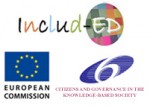The bases of the Communicative Methodology are:
Knowledge Constructed Through Intersubjective Dialogue
Meanings are constructed in interactive communication between people, reaching agreements. The researchers bring their expertise and the recent developments in the scientific community into the dialogue and this is contrasted with what social actors think and experience in their everyday lives. The researcher and the social agents share their knowledge in order to identify the strategies that overcome the exclusionary elements. This methodology requires to create the conditions that enable intersubjective dialogue between participants through an egalitarian relationship.
The communicative methodology assumes a series of postulates:
- Universality of language and action
- People as transformative social agents
- Communicative rationality, disappearence of the interpretative hierarchy
- Dialogic knowledge
Including Traditionally Silenced Voices
There is a direct and active participation of the people whose reality is studied throughout the entire research process.
The analysis of educational strategies that contribute to social cohesion and educational strategies that lead to social exclusion requires the inclusion of the maximum diversity of voices (i.e. all related stakeholders and end-users) and to draw from a wide range of sources. While the voices of vulnerable groups have been traditionally excluded from research, the communicative methodology relies on the direct and active participation of the people whose reality is being studied throughout the whole research process.
As for example, with the communicative methodology, vulnerable groups have seen the possibility to participate in a research that takes their voices into account in order to contribute to overcome their social exclusion. INCLUD-ED count on the participation of representatives from collectives of immigrants, people with disabilities, women, youth (at risk) and Romà , in the research through the Advisory Committee.
Several mechanisms have been foreseen to preserve the project’s ethical integrity and protect the study participants’ from any kind of misuse of the collected data about them.
Exclusionary and Transformative Components
Scientific analysis oriented towards identifying strategies that lead to social inclusion (transformative) and those which lead to social exclusion (exclusionary).
Scientific analysis oriented towards identifying strategies that lead to social inclusion (transformative) and those which lead to social exclusion (exclusionary).
The communicative data analysis helps to disclose the complexity of reality and to avoid simplistic explanations that categorise a dimension as entirely exclusionary or transformative. One of the most important objectives of communicative research is to focus on analysing inequalities and to contribute to solutions through dialogue among all agents involved. The exclusionary and transformative axis will facilitate the analysis of the educational strategies that contribute to social cohesion and those that deter it.
The communicative methodology provides the possibility to integrate and incorporate different disciplines and orientations, using distinct methods and techniques to collect and analyse data, that is to say, applying mixed methods (quantitative and qualitative). The different methods have been chosen according to research operational objectives but the communicative orientation will be held throughout the project.
